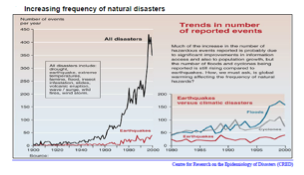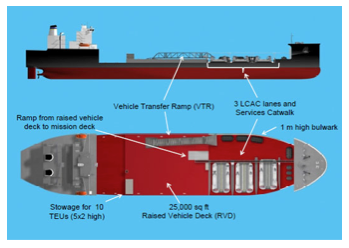Humanitarian Aid Ship
What vessels and sealift capability does UK Plc. have to support operations such as the after affects of a Super Typhoon like Haiyan?
HUMANITARIAN AID SHIP – USING THE SEA BASE PHILOSOPHY
SUPER TYPHOON HAIYAN
“If everyone is thinking alike, someone isn’t thinking.”
—General George Patton Jr.
Some of us, who have seen the appalling pictures from the Philippines in the wake of Super Typhoon Haiyan, may despair that yet again the nations of the world have failed to prepare themselves adequately for such disasters.
At least 10,000 people are thought to have been killed in the Philippine city of Tacloban, local officials believe. A further 300 are confirmed dead with 2,000 missing in the neighbouring island of Samar. Up to 4.3 million people are said to have been directly affected by the typhoon’s path and the death toll is expected to rise further as rescuers reach cut-off areas. We do not yet know the extent of the suffering on the mainland of Asia.
But, if the death toll estimate by government officials is confirmed, it would be the deadliest natural catastrophe on record in the Philippines.
As protracted internal conflicts have become more common and more deadly, the impact on civilians has multiplied. Post-Cold War conflicts have caused nearly six million casualties, and 95 percent of these have been civilians. In 2012, it was estimated that 53 million people were affected in different ways by conflict worldwide.
These disturbing developments have necessitated extensive humanitarian relief efforts and development assistance to rebuild war-torn countries after conflict has ended. Development assistance is also a long-term strategy for violence prevention. Although they are presented separately here, humanitarian aid and development assistance often overlap.
So what Is Humanitarian Aid?
Conflicts adversely affect civilians both directly, and indirectly, through the resulting “complex emergencies” that protracted conflicts create. In the immediate area of conflict, the primary aim is preventing human casualties and ensuring access to the basics for survival: water, sanitation, food, shelter, and health care. Away from the main fighting or disaster areas, the priority is to assist people who have been displaced, prevent the spread of conflict/maintain law and order support relief work, and prepare for rehabilitation
For many military forces, Humanitarian Aid and Disaster Relief (HADR) operations, commonly known as humanitarian effort is no longer a secondary mission. The increasing number of such tragedies has, in some governments awakened a consciousness to initiate and develop a co-ordinated, dare I say it, integrated civilian and military HADR.
Supporting humanitarian effort from the Sea
So what vessels and sealift capability does UK Plc. have to support operations such as the after affects of this Super Typhoon?
Well it is true that the Royal Navy has dispatched the Type 45 destroyer HMS DARING from Singapore. This £1Bn plus vessel is fitted with sophisticated sensors and weapons systems.
It will in the words of the Prime Minister, David Cameron “Provide humanitarian assistance, helicopter-lift capability from one onboard Lynx, and engineering and first aid expertise. The Type 45 destroyer also carries equipment to make drinking water from seawater”
Nevertheless, it is most unsuited to humanitarian aid effort.
In May this year the US accepted its first Mobile Landing Platform, – the USNS Montford Point (MLP 1), from General Dynamics-NASSCO, in San Diego.
The Mobile Landing Platform is a new class of ship and highly flexible and modular platform that will provide capability for large-scale logistics movements such as the transfer of light and heavy vehicles and equipment from sea to shore.
“MLP-1 has gone from concept to delivery in under five years, a remarkable feat reflecting the diligent work of the Navy and shipbuilding team from design through testing and trials,” said Capt. Henry Stevens, PEO Ships’ program manager for strategic and theater sealift. “With its open, reconfigurable mission deck, USNS Montford Point will deliver innovation and exceptional flexibility to future Fleet operations.”
The 83,000 ton, 785-foot ship will use float-on/float-off technology, allowing Montford Point to partially submerge, facilitating easy movement of cargo and craft. Additionally, the ship’s size allows for 25,000 square feet of vehicle and equipment stowage space and 380,000 gallons of fuel storage.
The George Patton Principle.
I have been involved in Sea Basing concepts for over 30 years and direct humanitarian aid effort for almost as long.
Wouldn’t it be nice if UK PLC showed some vision and allocated funds for vessels such as Montford Point – which is ideally suited for effort in Leyte rather than send a highly motivated Royal Navy crew of 190 onboard an 8000 tonne vessel designed to create a defensive shield around a task force – and troops ashore – protecting them from air attack but NOT the sort of capabilities needed in the aftermath of ‘Haiyan’.
Written by Malcolm Warr.




It is good to see that the UK is sending a ‘flattop’ HMS ILLUSTRIOUS. My late husband was Commander ‘Air’ onboard. At the very least ILLUSTRIOUS will provide an offshore platform for helicopter operations in support of the US led international effort but this is a ‘sticking plaster’ approach. We need a global humanitarian plan, proper resources and a willingness to implement by the international community